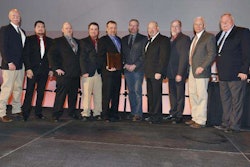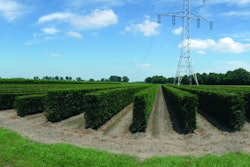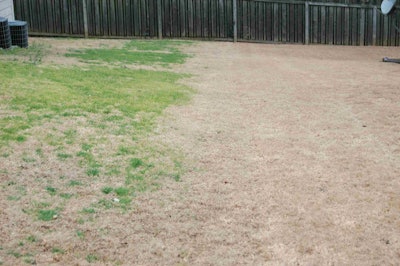 This photo shows a yard with one side treated with pre-emergent herbicides and the other side untreated.
This photo shows a yard with one side treated with pre-emergent herbicides and the other side untreated.Photo: Bayer
When it comes to applying pre-emergent herbicides, customers can sometimes be split on whether or not this service is necessary or even helpful.
To help shed some light on the subject, experts in the green and chemical care industry have weighed in on how pre-emergent herbicides work, why they are helpful, the equipment required to apply them, when to apply and which myths have merit and which are way off base.
How they work
For starters, let’s talk about how pre-emergent herbicides actually work. There are many different types of pre-emergent herbicides, and they can vary in carriers and chemical formulations.
They are applied to the soil either as a spray in the form of a liquid or spread as a granular. Once these herbicides are irrigated properly into the soil, a chemical barrier is formed, which controls the weeds as they germinate.
“With pre-emergent herbicides, you’re typically going to make a broadcast application to control weed seedlings after they germinate but prior to emergence – when the seedling puts out a shoot and root,” said Laurence Mudge, Bayer Green Solutions team manager. “Pre-emergent herbicides then offer residual control as seeds germinate throughout the season, effectively stopping the weed from ever ‘emerging’ from the soil.”
Are they profitable?
While this answer could vary from business to business, Kevin Roper, account manager with Landscape Workshop, LLC, has found pre-emergents to be extremely useful in his practice.
“Our company offers this service as part of our regular maintenance service,” Roper said. “Having effective weed control on a property not only looks great from a customer’s standpoint but also saves countless labor hours of hand pulling weeds and can reduce (the) frequency of mowings and string-trimmings needed.”
If your company doesn’t offer this service yet but has seriously considered it, there are a few things to consider before jumping in.
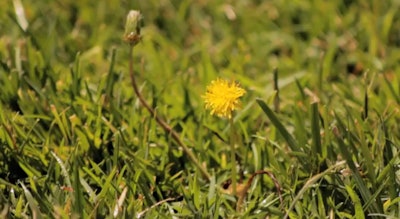
“Properly researching the chemical labels, asking suppliers and talking to extension services will help you decide,” Roper said. “Also, make sure that you have met the applicator licensing requirements prior to making any applications.”
When it comes to required equipment, Roper suggests the use of either a truck or trailer capable of holding a spray tank, engine, pump, hose reel and hose if liquid is your best option.
“There are some really nice 200 gallon, fully assembled units available that slide into a full-size pickup truck,” Roper said. “We have one of these that we often use. Having the spray unit all contained inside a bed of a pickup truck allows ease of access to most properties.”
Mudge recommends the use of a broadcast sprayer when servicing larger areas and the use of a backpack sprayer for smaller areas. When using granular products, Mudge says landscapers have the option of choosing a type that’s either impregnated on a fertilizer or a non-fertilizer formula. When this is the case, Mudge recommends the use of a push spreader, handheld sprayer or, for larger areas, a tractor-mounted applicator.
Liquid versus granular
Whether dealing with liquid or granular formulations, Mudge says that herbicide distribution is extremely important.
“Liquid applications by default deliver better herbicide distribution,” Mudge said. “Granular formulations, particularly on fertilizer, can vary in particle size, the spread rate (or amount of product per acre) and the particle distribution. With some fertilizer products, you’ll get fairly large particles and low spread rates that can actually allow weeds to germinate in between them. But there are some granular products…that have much smaller particles for improved distribution.”
Mudge adds that another big difference between liquid and granular pre-emergents is that more water will be required when using granular formulations, as it takes more water to get the herbicide off the granule and down into the soil.
For Roper, liquid formulations have proven to provide the most uniformed coverage for his customers, however, he does understand that liquids aren’t always an option for some areas.
“Some properties may have courtyards or areas that are not accessible by a spray hose,” Roper said. “If that’s the case, applying a granular product with a push spreader may be a better choice. Also, if you are offering a weed control service for shrubbery bed spaces, granular applications are a much faster method of delivery. Working in and around trees and shrubs with a hose can be a challenge. Hand or belly crank spreaders allow you to quickly apply granular products to beds.”
When to apply and what to charge
The next pressing questions surrounding pre-emergents are when do they need to be applied and how much should I charge for this service?
Mudge and Roper both recommend applying pre-emergents twice a year, once in the late winter/early spring going into summer and again in the fall.
“These times are critical to target (and) avoid seasonal seeds from germinating,” Roper said. “So, start offering your potential customers your service in the summer and winter. Turf weed control usually requires multiple applications throughout the year to achieve the best finished product. It is best to sell this service as a timed program to have the consistent weed-free look that customers are wanting.”
Roper adds that you can also customize the program based on the type of turf that will be treated and the needs of your customer by suggesting insecticide, fertilizer or fungicide applications.
As far as pricing is concerned, Roper says for his company the prices are set by the size of the area, such as acres or square feet. Roper also suggests calculating how long it takes your applicator to set an area consistently to generate labor costs.
“Also, the difficulty of the job may be a factor,” he adds. “A perfectly square acre will be much faster to treat than an acre of turf that is divided up in parking lot turf islands at a busy mall.”
Common myths
When it comes to myths associated with pre-emergent herbicides, some of the most common are:
- If you don’t have weeds, you don’t need to use pre-emergent herbicides
- If your lawn is thick, you don’t need to use them
- Soil aeration can break down the barrier and cause more weeds to grow
- There’s no reason to treat an entire area; spot treatment will suffice
- All pre-emergent herbicides are created equal
- Herbicide applications alone are all you need
Starting from the top of the list, Mudge and Roper share their insights to help determine which of these are fact and which are fiction.
Even if your customers don’t have weeds right this minute, that doesn’t mean they won’t have them in the future. Therefore, the first myth is false, according to both experts.
“If you don’t currently have weeds, chances are, you will,” Roper said. “Seeds invade properties from many sources. Wind, encroaching neighboring areas, mowers and even wildlife can promote undesired weed growth in your turf. You really should invest in weed control before a problem arises.”
If your customers have a lawn that is covered in thick grass, they may be tempted to decline this service based on the second common myth. While thick lawns may help hold weeds off longer than thinner ones, it won’t keep them gone forever. This myth, therefore, is also false according to the experts.
“A healthy lawn tends to help with reduction in weeds and helps pre-emergent herbicides work better,” Mudge said. “A lot of weed control is plant competition. Just because you have a thick lawn doesn’t mean you won’t have weeds – so in many cases, you’ll still want to use a pre-emergent herbicide, though you may be able to get by with a lower rate.”
When talking about soil aeration disturbing the weed barrier and causing more weeds to grow, Roper says it’s sort of a yes and no deal. Because the aeration pulls the plugs up, the soil underneath each plug is then left with no chemical protection. This leaves areas in place but not exposed to potential problems, and Roper suggests aerating the turf before any application to keep the barrier undisturbed.
“You’d think that aeration might break down the weed barrier and cause a problem, but research shows its effects are minimal,” Mudge said. “You technically are breaking the barrier – but you’re not affecting it much if any. The benefits of aeration far outweigh the potential loss of weed control.”
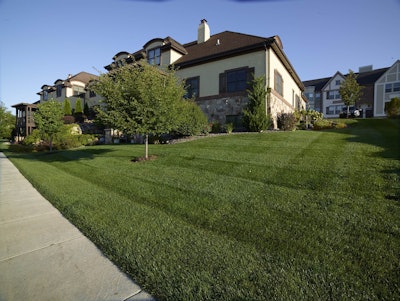 For lush, weed-free lawns like this, landscapers have to be proactive and apply pre-emergent herbicides.
For lush, weed-free lawns like this, landscapers have to be proactive and apply pre-emergent herbicides.Photo: Dow AgroSciences
When customers only see weeds appearing in one specific area of their landscape, they may be tempted to ask you to only spot treat with herbicides. The problem with this, according to Roper, is that the areas left untreated will still risk a potential outbreak of weeds.
“Full coverage will achieve the best results,” Roper said. “It is only a matter of time until weeds will start growing in untreated areas.”
Regardless of what customers may think, all pre-emergents are not created equal. Mudge says that all pre-emergents will have different strengths and weaknesses in regard to what they can and can’t control and how long they will last. Mudge encourages landscapers to know exactly what weeds they’ll be working with to ensure they are able to find the best herbicide option.
The final common myth we’ll touch on is that herbicides alone are really all you need. According to Mudge, herbicides are indeed an invaluable tool when it comes to weed control, but they work best when paired with a sound agronomic approach.
“You can’t just rely on herbicides and forget about agronomy,” Mudge said. “That turf has to be happy, so soil fertility is critical. A lawn with a bad soil pH is never going to grow well and will always have weed issues. At the right pH, you’ll have fewer issues with insects, disease and more. Crop and soil science is a fundamental part of effective plant management.”
In summary, Roper encourages landscapers to always read the labels to know exactly what your product can do; cheapest isn’t always the best if it doesn’t end up working to prevent the weeds in the area.
“If you apply a non-effective product and weeds explode in a customer’s yard, you just wasted not only the cost of that product, the labor involved, but also the cost of a return trip to correct the issue,” Roper said.



